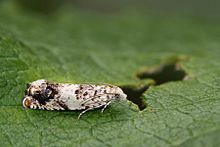Epinotia subocellana is a species of moth of the family Tortricidae. It is found in Asia and Europe and was first described by Edward Donovan in 1806.
| Epinotia subocellana | |
|---|---|

| |
| Epinotia subocellana | |
| Scientific classification | |
| Domain: | Eukaryota |
| Kingdom: | Animalia |
| Phylum: | Arthropoda |
| Class: | Insecta |
| Order: | Lepidoptera |
| Family: | Tortricidae |
| Genus: | Epinotia |
| Species: | E. subocellana
|
| Binomial name | |
| Epinotia subocellana (Donovan, 1806)
| |
| Synonyms | |
| |
Life cycle
editThe male and female moths are similar with a wingspan of 10–14 mm.[2] The head is ochreous-white. The forewings are ochreous-white, the costa and dorsum strigulated with dark fuscous. The basal patch is striated with black, interrupted near costa, and the edge obtusely angulated. The central fascia is mixed with pale ferruginous, leaden-metallic, and black, narrowly interrupted above middle. The ocellus is leaden metallic, with a central series of connected black marks. The apex has ferruginous and leaden-metallic striae.The termen is sinuate. The hindwings are fuscous, darker terminally, The larva is pale green; head yellow -brown.[3] The moths fly from May to July at dusk and come to light.[4] .
Ovum
editEggs are laid on rough-leaved willows (Salix species).[5]
Larva
editLarvae have a yellowish or greenish-white body and a yellowish-brown head. The prothoracic and anal plates are pale yellow. They live in a sandwich of two leaves spun together, feeding on the underside of the upper leaf, from August to October. Foodplants include eared willow (S. aurita), grey willow (S. cinerea) and goat willow (S. caprea).[5]
Pupa
editWhen fully fed the larva descends to the ground and overwinters in a cocoon. The pupa forms in April or May, is yellowish-brown and can be found in detritus.[2][5]
Distribution
editFound from western, northern and central Europe through to eastern Russia.[5]
References
edit- ^ "Epinotia subocellana (Donovan, 1806)". GBIF Global Biodiversity Information Facility. Retrieved 27 December 2018.
- ^ a b Emmet, A Maitland (1998). A Field Guide to the Smaller British Lepidoptera (Second ed.). London: The British Entomological and Natural History Society. p. 180. ISBN 0 9502891 6 7.
- ^ Meyrick, E., 1895 A Handbook of British Lepidoptera MacMillan, London pdf This article incorporates text from this source, which is in the public domain. Keys and description
- ^ Kimber, Ian. "Epinotia subocellana". UKmoths. Retrieved 27 December 2018.
- ^ a b c d Bradley, J D; Tremewan, W G; Smith, Arthur (1979). British Tortricoid Moths. Tortricidae:Olethreutinae. London: The Ray Society. pp. 102–03. ISBN 0 903874 06 7.
External links
edit